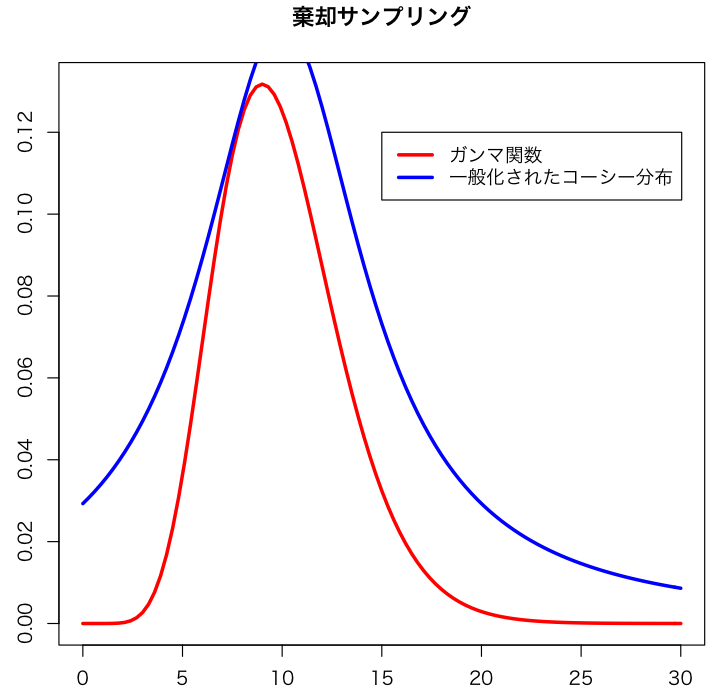をやってみるてすと。PRMLの第11章サンプリング法のところのP242とかです。
Suppose we can not make the random samples which come from gamma distribution. Let us consider making them from the cauchy distribution. So proposal distribution is the cauchy distribution. The plot these distribution is as follows.
k <- 2.3 plot(function(x){dgamma(x,shape=10)},0,30, ylab="",col="red",lwd=3) plot(function(x){k*dcauchy(x,scale=5,location=10)},0,30,add=TRUE,col="blue",lwd=3) title(main="棄却サンプリング") legend(15,0.12,c("ガンマ関数","一般化されたコーシー分布"),lwd=3,col=c("red","blue"))

In the above case, the constant value is 2.3. For all x in the domain, the generalized cauchy distribution is greater than gamma distribution.
According to the マルコフ連鎖モンテカルロ法 (統計ライブラリー) in page 7-8, rejection sampling is written as,
Even if it is difficult to sample from the target distribution directly, we may get the random numbers from the target distribution indirectly using the distribution which we can sample easily. Such a method is called rejection sampling or accept-rejection sampling. Let
.
represents the probability density function and C is the normalizing constant term which makes sum of
be equal to 1. When it is difficult to sample from
, suppose that there is the distribution function
which can easily generate the random numbers, and
has the constant value
which satisfies
. Under such assumptions, we can generate the random numbers from
indirectly as follows.
- generate random number
from
.
- calculate ratio
.
- generate the uniform random number
from interval
.
- adopt
if
, otherwise return to 1.
And I implemented above algorithm with R. The program is as follows.
myrand <- function(){ x <- rcauchy(1,scale=5,location=10) alpha <- dgamma(x,shape=10) / (k * dcauchy(x,scale=5,location=10)) u <- runif(1) if(u < alpha){ return(x) }else{ print("false") myrand() } } n <- 1000 qqplot(rgamma(n,shape=10),sapply(1:n,function(x){myrand()}),xlab="random numbers from gamma distribution",ylab="random numbers from myrand")

The above qqplot seems to be linear, so I found my program went well.

- 作者: C.M.ビショップ,元田浩,栗田多喜夫,樋口知之,松本裕治,村田昇
- 出版社/メーカー: 丸善出版
- 発売日: 2012/02/29
- メディア: 単行本
- 購入: 6人 クリック: 14回
- この商品を含むブログを見る